NVIDIA's GeForce GTX 550 Ti: Coming Up Short At $150
by Ryan Smith on March 15, 2011 9:00 AM ESTPower, Temperature, & Noise
Last but not least as always is our look at the power consumption, temperatures, and acoustics of the GTX 550 Ti. As a result NVIDIA’s tinkering with both power efficiency and clocks, performance has gone way up but power has also gone up too: the official TDP has gone up by 10W.
Please note that as we don’t have a true reference card our testing methodology has been slightly tweaked. We’ve tested the AMP at both GTX 550 Ti reference clocks and at its factory overclock for all metrics, however noise and temperature in particular are going to significantly vary from manufacturer to manufacturer.
| GeForce GTS 450 & GTX 550 Voltage | ||||
| GTS 450 | Zotac GTX 550 Ti Amp | Idle | ||
| 1.05v | 1.1525v | 0.95v | ||
The load voltage on our Zotac AMP is 1.1525v, which compared to GF106/GTS 450 ends up being quite high. No doubt Zotac has given the card some more voltage to handle the factory overclock, however this will also skew our power results for load. Idle however remains unchanged at 0.95v.
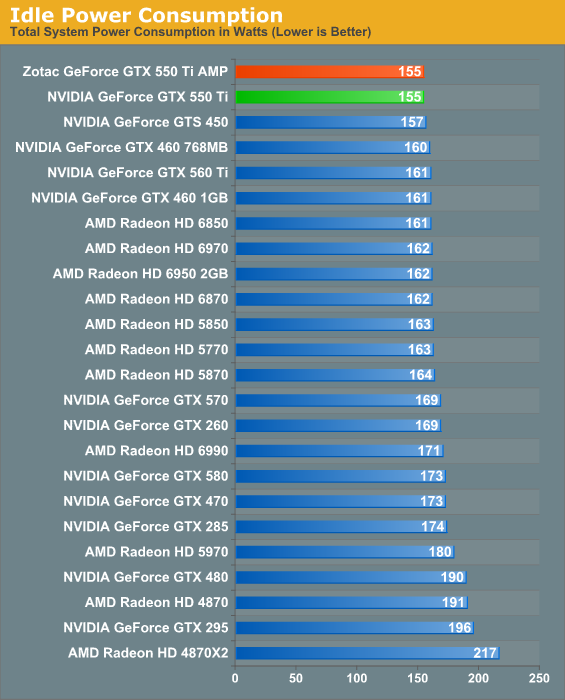
Right off the bat, idle power consumption looks good. At 155W the Zotac GTX 550 AMP beats even the reference GTS 450 by 2W, and the gap with the Radeons is much larger. Here we’re looking at a 6W advantage over the 6850, and 8W over the 5770. This is no small feat given how hard it is to reduce idle power usage, and showcases the benefits of NVIDIA’s transistor tinkering.
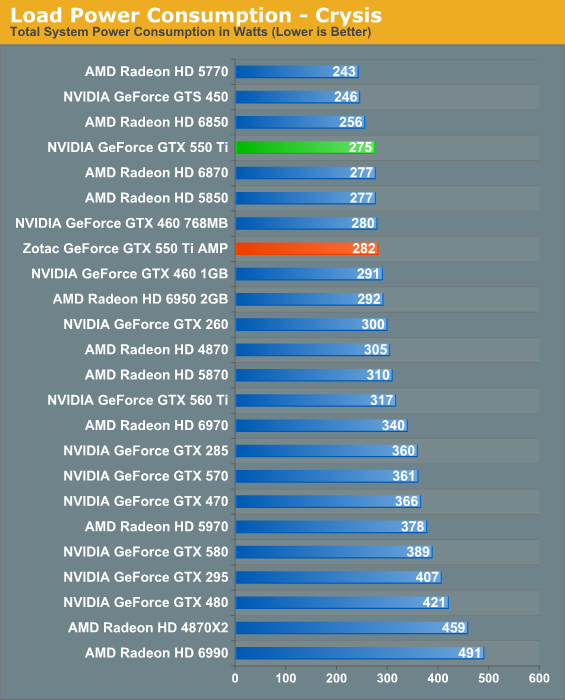
Power consumption leaves much to be desired however, and it’s at this point that we can’t easily separate the GTX 550 Ti from the Zotac GTX 550 AMP. If the Zotac card did not have an overclock, perhaps it would have a lower load voltage, and as such lower power draw under load. But in this case it does not, which leads to a total system power draw difference of 19W over the 6850, never mind the 5770.
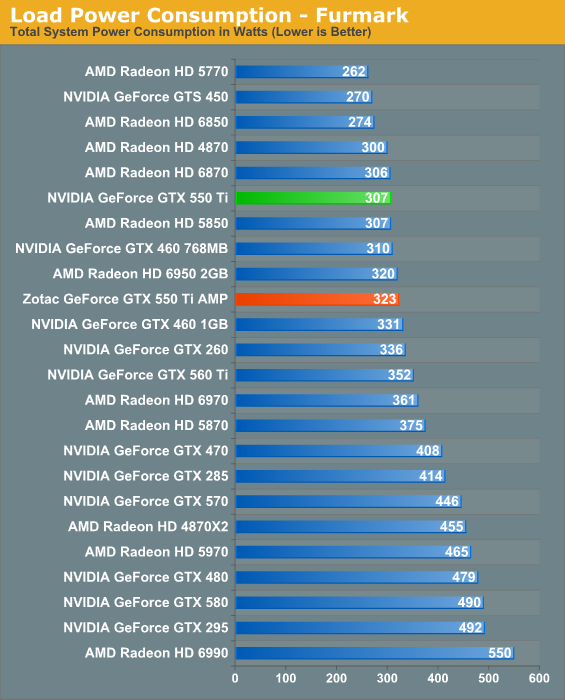
The GTX 550 Ti does not have any kind of overcurrent protection like the rest of the GTX 500 series, so here we can get straight numbers without forcibly disabling it. The results, like with Crysis, are understandably poor for the card; 33W over the 6850, more for the card when it’s running at factory clocks. If a more reference style GTX 550 Ti is anything like this, it bodes poorly for the card compared to the already faster 6850.
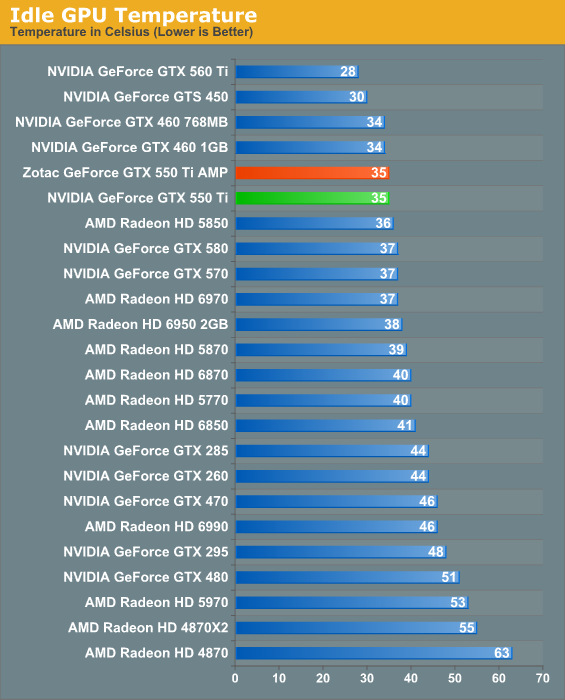
The king of our idle temperature charts is composed of NVIDIA reference cards, and while the Zotac GTX 550 AMP gives a decent performance, it can’t keep up. 35C at idle is still quite good, but we saw better on the GTS 450, and would likely see something similar on a reference GTX 550 Ti.
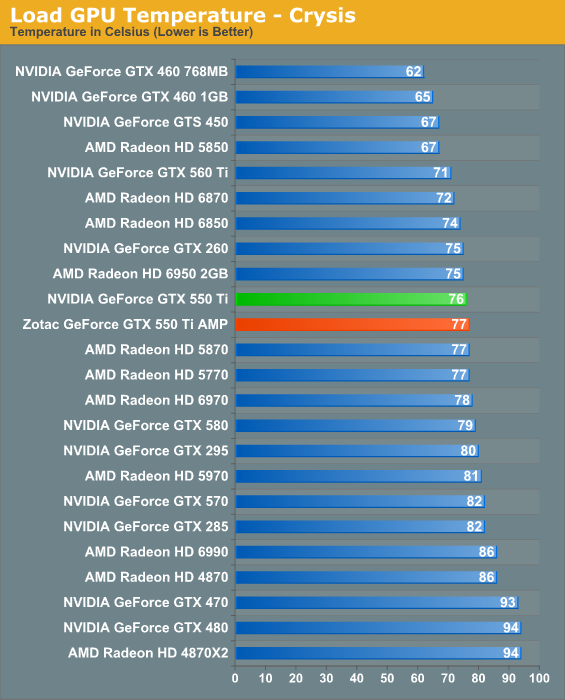
Under load, temperatures end up being middle the road, thanks once more to the card’s higher power consumption. Funny enough it does beat the 5770 by 1C even after all of this, but one could just as well slap the GTX 460 cooler on here and get results that would undoubtedly be below 70C.
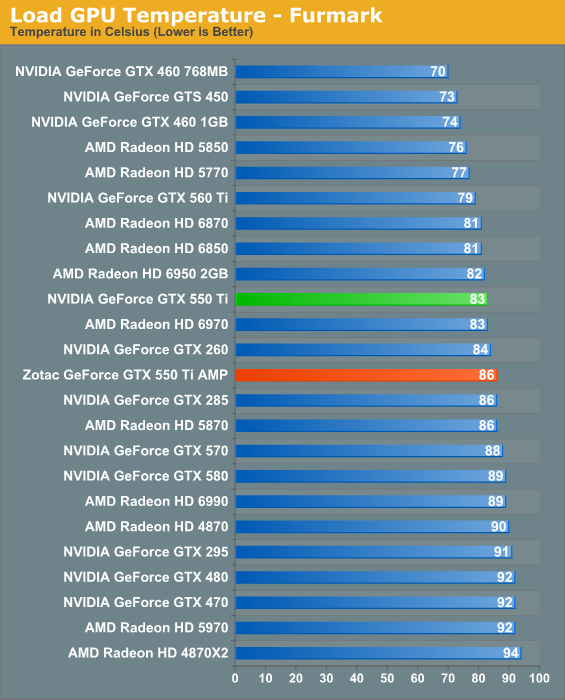
FurMark of course adds several C more to our temperatures. In fact for a lower power card like the Zotac GTX 550 AMP we’re actually caught a bit off-guard. 86C at factory clocks means there’s some thermal headroom to play with for overclocking, but not too much – the GTX 550 Ti’s max temperature is only 95C.
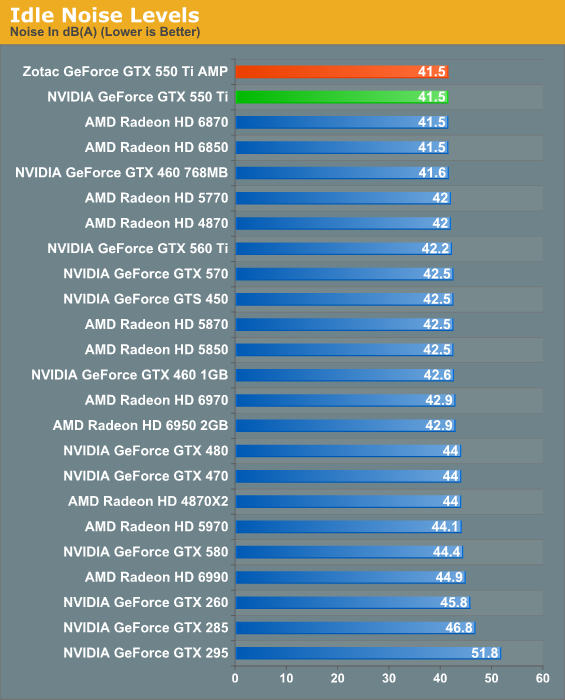
For cards in this performance category, idle noise is pretty consistent thanks to the common use of open coolers. The Zotac GTX 550 AMP doesn’t disappoint here, offering a practically silent 41.5dbA as measured by our meter.

If you were hoping that higher temperatures would be a precursor to lower fan noise, you’re going to come up empty handed here. 50.7 is by no means loud among all the cards we’ve tested, but we’ve seen better. In fact the 5770/6850 both do better, as does the GTX 460 and GTX 560. At the AMP’s full factory overclock we get up to 54.4dbA, which is certainly going to be noticeable. Unfortunately the card doesn’t have the performance even with the overclock to justify the noise.
Ultimately this is less a discussion of the GTX 550 Ti reference design, and more a discussion on the Zotac GTX 550 Ti AMP’s design, which more likely than not takes a hit in cooling and temperatures thanks to the 2nd DVI port partially blocking the card’s external exhaust. But for the time being, it’s what we have to work with.










79 Comments
View All Comments
Marlin1975 - Tuesday, March 15, 2011 - link
But over priced.If this was in the $100 area it be a much better buy. But the cheaper 460 is better right now.
Also you have the 450 in yoru graph as a 256bit bandwidth, not the 128bit it is.
vol7ron - Tuesday, March 15, 2011 - link
I'm not usually an advocate of OCing gpus, but I'm curious how much more performance could be achieved. We know there's some room in the memory, how much more can the gpu/shaders really extract? While Zotac OCs, they normally don't max it out on air cooling, so a little testing would be nice :)slickr - Tuesday, March 15, 2011 - link
Its a crap card.Its about $50 overpriced, its worse in consumption, noise and coolness than Nvidia's own 1 year old GTS 450.
So how can this be a good card? For the same price I can get a GTX 460 768mb that performs 20% faster and I can get cooler, quieter and less power draw card for $50 less in the 5770 and still get the same performance.
If you ask me this card is a rip off for consumers who don't know anything about graphic cards.
Aircraft123 - Tuesday, March 15, 2011 - link
I really don't understand why nVidia is so concerned with these lower performing cards.Their own cards from TWO GENERATIONS AGO perform better then this "new" card.
I have a GTX275 it will perform equivalent or better than this new card and you can find it on a particular auction site for ~$100.
The only thing missing from my 275, is directX 11. Which unless you get a 470 or greater the card isn't powerful enough to run any dx11 stuff anyway.
I could also say the same for AMD considering the 4870 performs better than the 5770.
I am interested in the dual fermi card due out soon though. It will be interesting if/how they can beat the 6990 with lower power sonsumption/noise.
Anyhow good article.
Marlin1975 - Tuesday, March 15, 2011 - link
The reason is the re-work I bet has a better yeild number, let alone more performance from the same chip with a new series number.So people think they are getting new cutting edge when its just a 4xx series chip re-worked.
Taft12 - Tuesday, March 15, 2011 - link
In fairness, if we are considering dollars and cents your GTX275 has a TDP twice the 550 Ti, and probably eats up double or more at idle as well.jiffylube1024 - Tuesday, March 15, 2011 - link
The GTX 275 costs a lot more to make than the Ti 550 (they couldn't mass manufacture the GTX 275 card at a $100 or even $150 pricepoint and hope to make a profit) and a GTX 275's that you could find for $100 today would either be old stock (meaning they're just clearing inventory) or a used card, meaning no profit for Nvidia whatsoever.It's pretty obvious that companies come out with these cards to occupy lower pricepoints... The problem is that, as you point out, they are often too cut-down and previous generation cards throttle them. It's a balance, and when they hit the right price/performance, magic happens (GTX 460), but they often miss the mark on other cards (GTS 450, Ti 550).
Even if you examine the Ti550 on paper, it stands no chance vs the GTX 460 -- it has 56% less shader power than the GTX 460 (336 shaders vs 192; a similar drop in texturing power) and not enough of a clockspeed advantage (900 MHz vs 675 MHz) to make up for that. At $150, the Ti550 is a total waste since you can find GTX 460's for $130 or less these days. It's going to take a fall below $100 for these cards to become worthwhile.
Nevertheless, if GTX 460 stock dries up, then without a Ti 550, Nvidia has a gaping hole below $250.
I think this has a lot to do with manufacturing costs -- it's not economical to keep making GTX 460's and sell them for ~$100. The Ti 550 has 66.7% the transitor count of the GTX 460, meaning a much cheaper die to manufacture.
Kiji - Tuesday, March 15, 2011 - link
"Indeed the GTX 550 Ti is faster than the 5770 - by around 7% - but then the 5770 costs 36% more." - I think you mean "..36% less."Good review, and it's disappointing NVidia doesn't want to change their mentality.
Kiji - Tuesday, March 15, 2011 - link
Nevermind, already fixed :)passive - Tuesday, March 15, 2011 - link
At the end of page 5 you say that the 550 is ahead of the 5770 by 50%, and at 90% of the 6850. According to your graphs, both of these are very wrong (even when using the Zotacs numbers):23.1 (550) / 19.8 (5770) = 16.6%
23.1 (550) / 29.8 (6850) = 77.5%
What's weird is that immediately after you say how the 550 is beating the 450 by 30%, which is accurate, but further paints a pro-Nvidia picture.
I know we live in era of community edited content, but in order to prevent accusations of bias, you should really catch this before you publish.